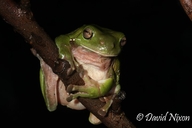|
Distribution and Habitat
Country distribution from AmphibiaWeb's database: Australia, Indonesia, Papua New Guinea. Introduced: New Zealand, United States. U.S. state distribution from AmphibiaWeb's database: Florida
Widespread species. Distributed from the Kimberley Region of Western Australia, through most
of Northern Territory, all of Queensland, northern and central New South Wales and the north-
east corner of South Australia.
The extent of occurrence of the species is approximately 4078600 km2.
Life History, Abundance, Activity, and Special Behaviors
Found commonly near streams and swamps on rocks and trees or in crevices in rocks and
hollow tree trunks. Also found in domestic environment, including letterboxes, toilet bowls and
cisterns, bathrooms and meter boxes. Commonly kept as a pet within Australia and overseas
(but now protected).
Breeding occurs from November to February. Males call from hidden localities near water and
often downpipes. Clumps of 200 – 2000 eggs are deposited on the surface of still water. The
spawn sinks within 24 hours. Development is usually complete in 6 weeks.
Trends and Threats
No known declines and large extent of occurrence.
Threats
Pollution and predation by cats and dogs is a threat where the species occurs in suburban
areas. Some animals have been found to be sick with chytrid fungus. Collection of tadpoles and
movement of tadpoles. Juveniles often relocated by the transportation of fresh produce.
Conservation Measures
None in place, except restrictions on pet industry i.e. must have a permit to keep frogs.
References
Barker, J., Grigg, G. C., and Tyler, M. J. (1995). A Field Guide to Australian Frogs. Surrey Beatty and Sons, New South Wales.
Tyler, M.J., Smith, L.A., and Johnstone, R.E. (1994). Frogs of Western Australia. Western Australian Museum, Perth.
Originally submitted by: Jean-Marc Hero et. al. (first posted 2002-04-05)
Edited by: Ambika Sopory (2008-09-16)Species Account Citation: AmphibiaWeb 2008 Litoria caerulea: Green Tree Frog <https://amphibiaweb.org/species/1348> University of California, Berkeley, CA, USA. Accessed Nov 22, 2024.
Feedback or comments about this page.
Citation: AmphibiaWeb. 2024. <https://amphibiaweb.org> University of California, Berkeley, CA, USA. Accessed 22 Nov 2024.
AmphibiaWeb's policy on data use.
|






 Map of Life
Map of Life